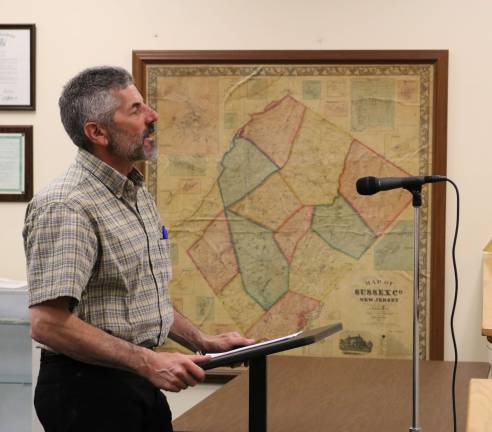Lake cleanup could cost Sussex $10K

SUSSEX BOROUGH — The Sussex Borough Council was left with one very big question to answer after a presentation from Larry Kovar of Aquatic Analysis at Tuesday night’s meeting.
What will be the future of Clove Lake?
The council is left to ponder a $10,600 plan to remove invasive species from the lake and will vote on a proposal at the next meeting.
Kovar, who has been contracted by the borough to do an initial survey of the lake, presented some of his findings, and a tentative action plan in going forward with the treatment of the lake, which has become ecologically unstable.
“The goal for now,” Kovar said, “is to get the lake in good ecological balance.”
Kovar noted that the lake suffers from invasive species of both plants and animals, limiting its use to the residents of the borough.
Of six different species of aquatic plants observed by Kovar and his team, two were found to be non-native to New Jersey.
Eurasian Watermilfoil, which is native to Europe, Asia, and North Africa, and Curly-Leaf Pondweed, native to Eurasia, has besieged the lake, and is choking out the native vegetation.
Kovar noted that several lakes across New Jersey are dealing with these invasive species as well.
The non-native species out-compete the native species along what is called the littoral zone. The littoral zone is the shallow shelf, about 6 feet deep, where sunlight can still penetrate the water. It encircles the main body of the lake.
The littoral zone is critical for wildlife, erosion control, and the overall ecological balance of the lake.
The native species of aquatic plants naturally grow shorter and remain submerged, while the non-native species grow taller and may breach the surface. The non-native species, in-effect, choke out the native species by limiting the amount of sunlight they receive.
By growing to the surface, the non-native species also limit the natural movement of the water, causing stagnation, which can lead to dangerous algae growth.
The other, and perhaps more serious threat to the lake is the waterfowl, specifically, the geese.
Not only do the geese bring in these invasive species, but what they leave behind is damaging the lake as well.
The nutrient load from all the geese waste can be as much as a 1,000 gallon septic-system, according to Kovar.
The geese also bring in water chestnuts, another invasive species that, according to Kovar, “once it (water chestnut) gets into an eco-system, it’s very hard to manage it.”
Some actions have been taken to control the geese population, who have nested at what was an active community beach in the 1950’s.
Kovar also noted the threat of blue-green algae, which can form in the summer months. Not only does blue-green algae kill plants and animals, it can be toxic to humans.
All the negative factors affecting the lake can result in dangerous Ph-levels and less dissolved oxygen in the water, which can kill just about anything that lives beneath the surface of the water, and pollute bodies of water downstream.
Kovar proposed a plan for the summer, which includes bi-weekly surveys of the lake; 4-5 algae treatments, and 1-2 weed treatments.
But even after getting the lake in a good ecological balance, Kovar asked the council to consider what their goals are for the lake and community.
If the council decide it wants to make the lake available for recreational swimming and watersports, a more aggressive, and more costly, solution to cleaning up the lake could be pursued.
Another option could be to just make the lake safer for activities like fishing and boating, or they could decide that having the lake in a good ecological balance and be aesthetically pleasing is enough.
Kovar asked the Borough council to consider what their goals are for Clove Lake, and requested a meeting at the end of summer to discuss future possibilities.